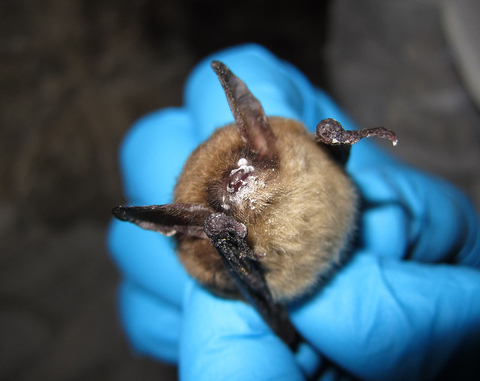The U.S. Fish and Wildlife Service recently reclassified the northern long-eared bat (Myotis septentrionalis) as endangered under the Endangered Species Act (ESA). The species is facing a rapid decline in population due to the impacts of white-nose syndrome, an invasive fungus that most visibly grows on the nose of bats.
White-nose syndrome impacts bat hibernation, causing them to wake up during the winter, use stored energy and deplete important fat reserves, often leading to starvation before spring. White-nose syndrome spreads rapidly and is devastating for bats that hibernate in large colonies during the winter.
During the winter, northern long-eared bats will travel between 40 and 60 miles to hibernate, congregating in caves or old mines with other species such as little brown bats (Myotis lucifugus) and tri-colored bats (Perimyotis subflavus). Unfortunately, these large gatherings aid in the spread of white nose-syndrome.
The northern long-eared bat population was wiped out in Soudan mine, a major winter hibernaculum, for this very reason. Historically, about 2,000 bats overwintered in the mine at Lake Vermilion-Soudan Underground Mine State Park each year, but by 2019 the entire population was gone. In response to this outbreak and others like it, mine and cave visitors are asked to follow decontamination procedures to try and slow the spread.
What you can do to help bats
While scientists work to find treatments for white-nose syndrome, Minnesotans can support northern long-eared bats by ensuring that they have food, water and shelter. Woodland owners can use one or more of the following bat-friendly forest management practices for creating and maintaining healthy habitat.
Retain large, old trees with cracks and crevices
Throughout summer in Minnesota, northern long-eared bats can be found roosting in trees during the day. Bats will use cracks and crevices from just off the ground all the way up to over 60 feet into a tree’s canopy. Loose bark and broken tree limbs and trunks are also used occasionally.
Northern long-eared bats are generalists and will use a diversity of mostly deciduous tree species and cavity types. They love maple trees for roosting, and are also frequently found in aspen trees in the north woods, ash in central Minnesota, and oak in the southern part of the state.
Nursing moms roost together in colonies ranging from 15 to almost 80 bats, and will shift maternity roost sites every day or two, even when lactating. Before the young bat can fly, mom will carry her single baby between maternity roost sites, so access to clusters of roosting trees within 300 yards of each other is important.
Install bat boxes
Northern long-eared bats also use structures to roost. If you don’t have big old trees, consider installing bat boxes to provide shelter. There are many options and designs available, including rocket boxes or double-chambered bat boxes.
Steward a diverse ecosystem
All of Minnesota’s eight native bat species are insectivores, supplying a critical form of natural pest control. Northern long-eared bats eat mostly moths, beetles and flies and do most of their feeding in the first two hours after sunset. Having a healthy, resilient ecosystem of native trees and plants that enables native insects to thrive is critical to bat survival.
Hire a forester or natural resource professional when managing your woods
You’ve heard this recommendation before, but you should always have professional help with any timber sales on your property. Your forester can help you design a timber harvest that will create open space for bats to gather insects while keeping roost trees safe for them as well. They can also help you understand the DNR’s Lakes States Forest Management Bat Habitat Conservation Plan, including what permits may be needed for management operations and how to get them.
Plant new trees for future bat generations
I’m delighted to share that the Extension Forestry team is working on recommendation lists of native trees and plants that are climate change resilient, work well with surrounding native plant communities, and are beneficial for Minnesota’s various charismatic microfauna like bats, pollinators and fireflies. Look for more on this exciting project this spring!


